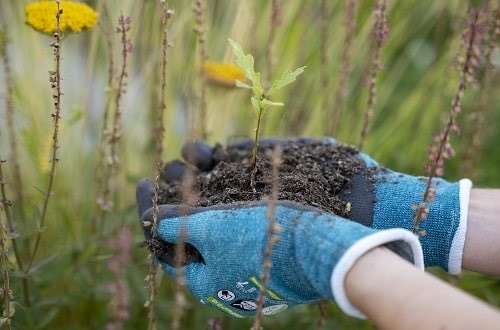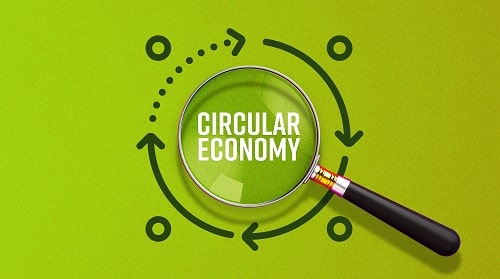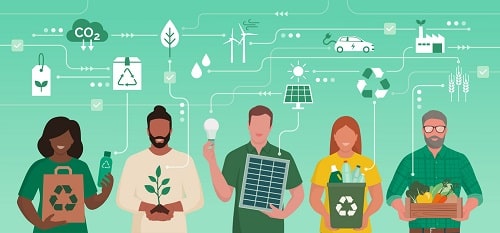With businesses increasingly keen to minimise their carbon footprint by selecting materials and products with the lowest carbon emissions, PPE specialist uvex has started offering data on the amount of greenhouse gases its products generate.
Features
Purchasing PPE: why sustainability data is becoming crucial
Since 1926, uvex’s commitment to protecting people has evolved to include safeguarding the environment. Over the past decade, we have slashed our CO₂ (carbon dioxide) emissions footprint by 70 per cent and made significant progress on product durability, recycling concepts and the use of bio-based materials.
This has included the launch of our ‘protecting planet’ range, which includes a head-to-toe sustainable personal protective equipment (PPE) offering. Our commitment to sustainability extends across products like helmets, gloves, earplugs and eyewear, employing recycled materials and eco-friendly packaging. The uvex xact-fit planet earplugs, for example, are manufactured using almost 100 per cent renewable energy.
We have also made notable progress integrating polyurethane surplus from our production processes into safety shoes and boot midsoles without compromising performance, with a goal for all footwear models to incorporate recycled or bio-based components within the near future.
 Photograph: uvex
Photograph: uvex
At uvex we actively pursue energy efficiency in manufacturing with the aim of reaching carbon neutrality by 2045, five years ahead of the European Green Deal schedule, a set of policy initiatives from the European Commission aimed at making the European Union (EU) climate neutral by 2050. Green electricity usage since 2014, solar panels, water consumption monitoring and eco-friendly building practices contribute to uvex’s sustainability ethos.
The new Bavarian logistics centre – currently under construction and due to open in the autumn – has achieved gold pre-certification by the German Sustainable Building Council, a testament to our holistic approach to environmental, economic and sociocultural factors.
uvex’s autonomy, with the PPE manufacturer 100 per cent owned by the uvex safety group and over 61 per cent of uvex products manufactured in-house, enables these extensive sustainable practices.
Calculating carbon savings
Building on the ‘protecting planet’ range, at uvex we are now offering data on the amount of greenhouse gases generated by our products. While we are one of the first manufacturers in our sector to do this, we expect this practice to become increasingly commonplace. With the CSRD (Corporate Sustainability Reporting Directive) and EU Taxonomy Regulation soon to come into force (requiring large and listed companies in the EU to annually disclose detailed sustainability information, including environmental impact, social responsibility and governance practices), the carbon footprint of every product used in a company (including PPE), is set to become an important part of the organisation’s overall carbon footprint.
As there are multiple greenhouse gases that contribute to global warming, CO₂ equivalent
(CO₂ –eq) provides a standardised assessment of their effects.
CO₂ is the most well-known greenhouse gas and serves as the reference value with a CO₂ equivalent of 1. Other greenhouse gases, such as methane (CH₄) and nitrous oxide (N₂O), have a much stronger warming effect on the Earth’s atmosphere than CO₂, thus they have higher CO₂ equivalents. The CO₂ equivalent of a greenhouse gas indicates how much that gas contributes to global warming compared with CO₂.
The CO₂-eq values allow for comparisons between standard uvex products and those with sustainable features, such as proportions of recycled or bio-based materials. The amount of CO₂ saved per product can easily be extrapolated to the number of employees in a company. This can quickly lead to significant savings in relation to the service life, thus immediately reducing the company’s CO₂ footprint.
For example, a uvex 1 G2 planet safety shoe with 30 per cent degranulated material has a calculated carbon footprint of 7.2kg (7.17kg) CO₂, saving 1.3kg CO₂ against the standard model of the uvex 1 G2 with a knitted shaft, with a 8.5kg CO₂ calculated carbon footprint. Assuming a service life of 12 months for both the uvex 1 G2 planet shoe and the standard version, if the uvex 1 G2 planet was issued to and worn by 900 employees, this would mean a saving of just over one tonne of CO₂ per year (1,170 kg) for 900 employees. That is equivalent to driving a mid to large sized car for about 3,556 miles.
To calculate the CO₂ footprint of a product, uvex uses SimaPro software based on the ecoinvent database, which contains life cycle inventory data on energy, materials and transportation, etc.
This software examines where the various components are produced, the production processes, transport routes and methods as well as any disposal processes. The result, including any background processes, is calculated using the data obtained. There are so many different factors when making a product that uvex recognises it is a long-term project to have precise figures for every single part of a product, but it provides a highly detailed estimate. And, as developments are taking place continuously it is becoming increasingly precise. The process is done according to ISO 14067 and allows us to produce very authentic carbon footprint figures.
The calculations represent an important step forward, helping buyers to better understand which companies and products are truly sustainable.
We need to bring transparency into the whole field of sustainability. Providing these figures is a huge achievement because it means we can show something tangible rather than just relying on claims. We believe it will become the norm to compare the CO₂ emissions of products in the future in the same way as we currently compare the prices of products.
Growing demand for data
With sustainability woven into the fabric of uvex, we are well-placed to assist with the growing interest in calculating carbon emissions – particularly in certain industries such as automotive.
The European Green Deal has set the target that Europe will be the first climate-neutral continent by 2050. This means for companies, saving CO₂ will become as natural as saving costs, because CO₂ will cost money directly and indirectly through CO₂ pricing.
Companies’ carbon footprints include not only what they themselves emit during the manufacturing process but also anything they source. These are categorised as Scope 3 emissions and the data is something that uvex’s customers are specifically demanding, making the company’s ability to provide carbon footprint data at component and product level a huge selling point.
More sustainable requirements are also appearing on tenders, with businesses such as large construction companies looking for partners that can offer evidence-based initiatives to help them to achieve their sustainable credentials and win business.
There is also growing recognition that partnering with a knowledge provider like uvex can be invaluable in helping to educate and guide customers through the maze of sustainable policies and practices.
Looking ahead
uvex has been blazing a trail for sustainability within the industry for some time. Ultimately, we want to help transform our linear economy into a circular one.
We’re not just saying, ‘OK, we’ll include recycled content in our products, tech, sustainable product – done.’ It’s about rethinking the whole concept and the way we might approach business models and service models in the future. Circularity means keeping the product or the materials of the product in the loop as long as we can. Beyond that, it means thinking about refurbishing options and biodegradability. Composting, for example, means closing the biological loop.
Creating circular PPE is a bold vision but, for uvex, it’s just one more step along a road we have been walking down for decades.
Verena Keller is sustainability development lead at uvex.
For more information see: https://www.uvex-safety.co.uk/en/
FEATURES

How to build circular economy business models
By Chloe Miller, CC Consulting on 07 April 2025
Widespread adoption of a circular economy model by business would ensure greater environmental and economic value is extracted and retained from raw materials and products, while simultaneously reducing carbon emissions, protecting the environment and boosting business efficiency and reputation.

What does the first year on an accelerated net zero path have in store for UK businesses?
By Team Energy on 07 April 2025
The UK is halfway to net zero by 2050 and on a new, sped-up net zero pathway. In light of this, Graham Paul, sales, marketing & client services director at TEAM Energy, speaks to TEAM Energy’s efficiency and carbon reduction experts about the future of energy efficiency and net zero in the UK.

Aligning organisational culture with sustainability: a win, win for the environment and business
By Dr Keith Whitehead, British Safety Council on 04 April 2025
The culture of an organisation is crucial in determining how successfully it implements, integrates and achieves its sustainability and environmental goals and practices. However, there are a number of simple ways of ensuring a positive organisational culture where everyone is fully committed to achieving excellent sustainability performance.



